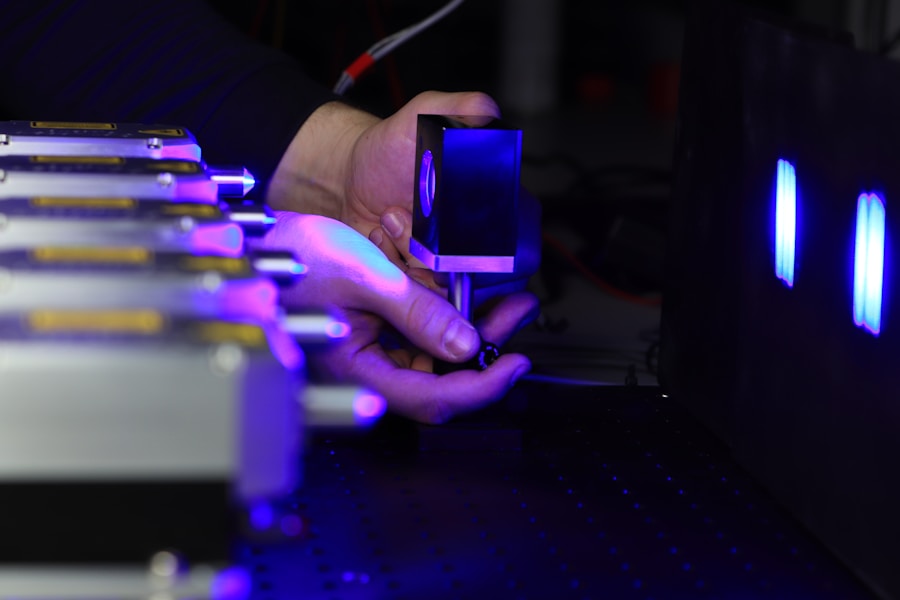Laser hair removal is a popular cosmetic procedure that uses concentrated beams of light to remove unwanted hair. The process involves targeting the hair follicles with the laser, which damages them and inhibits future hair growth. The procedure is typically performed by a trained professional in a medical spa or dermatologist’s office. It is important to note that laser hair removal is not a one-time treatment, as multiple sessions are usually required to achieve the desired results. The number of sessions needed can vary depending on factors such as the area being treated, the thickness and color of the hair, and the individual’s skin type.
During the procedure, the technician will use a handheld device to deliver the laser pulses to the targeted area. The sensation of the laser can be described as a mild stinging or snapping feeling, but most people find it tolerable. It is important to follow the technician’s instructions during the procedure, such as wearing protective eyewear and avoiding sun exposure before and after treatment. Overall, laser hair removal is a safe and effective way to achieve long-term hair reduction.
Laser hair removal works by targeting the pigment in the hair follicles, which absorbs the light and converts it into heat. This heat damages the follicle and inhibits future hair growth. It is important to note that laser hair removal is most effective on individuals with light skin and dark hair, as the contrast between the two makes it easier for the laser to target the hair follicles. However, advancements in technology have made it possible for individuals with darker skin tones to also benefit from laser hair removal. It is important to consult with a qualified professional to determine if you are a good candidate for the procedure.
The Benefits and Drawbacks of Laser Hair Removal
There are several benefits to laser hair removal, including long-term hair reduction, precision targeting of specific areas, and minimal discomfort during the procedure. Unlike traditional methods of hair removal such as shaving or waxing, laser hair removal offers a more permanent solution to unwanted hair. Additionally, the precision of the laser allows for targeted treatment of specific areas, making it ideal for areas such as the face, underarms, and bikini line. Many people also find that laser hair removal is less painful than other methods, with some describing the sensation as similar to a rubber band snapping against the skin.
However, there are also some drawbacks to consider when it comes to laser hair removal. The procedure can be costly, especially when multiple sessions are required for optimal results. Additionally, some people may experience temporary side effects such as redness, swelling, or skin irritation following treatment. It is also important to note that laser hair removal may not be effective for everyone, particularly those with light or fine hair. It is important to weigh the benefits and drawbacks of laser hair removal before deciding if it is the right option for you.
Preparing for Laser Hair Removal: What to Expect
Before undergoing laser hair removal, it is important to properly prepare for the procedure to ensure optimal results and minimize potential risks. One of the first steps in preparing for laser hair removal is to schedule a consultation with a qualified professional. During this consultation, the technician will assess your skin type, hair color, and medical history to determine if you are a good candidate for the procedure. They will also discuss the expected number of sessions needed and any pre-treatment instructions.
In preparation for laser hair removal, it is important to avoid sun exposure and tanning beds for at least six weeks prior to treatment. This is because tanned skin can increase the risk of complications such as burns or changes in pigmentation. Additionally, it is important to avoid plucking, waxing, or electrolysis for at least six weeks before treatment, as these methods can disturb the hair follicles and interfere with the effectiveness of the laser. Shaving is typically allowed in the days leading up to treatment, as it does not affect the follicle itself.
Potential Risks and Side Effects of Laser Hair Removal
While laser hair removal is generally considered safe, there are potential risks and side effects to be aware of before undergoing treatment. Some common side effects include redness, swelling, and skin irritation immediately following treatment. These side effects are typically mild and subside within a few hours to a few days. In some cases, patients may also experience changes in pigmentation or scarring, although these risks are rare when performed by a qualified professional.
It is important to follow all pre- and post-treatment instructions provided by your technician to minimize potential risks and side effects. This may include avoiding sun exposure, using sunscreen, and avoiding certain skincare products in the days following treatment. It is also important to communicate any concerns or changes in your skin with your technician to ensure that any potential issues are addressed promptly.
Choosing a Qualified Professional for Laser Hair Removal
When considering laser hair removal, it is important to choose a qualified professional who has experience and training in performing the procedure. One way to ensure that you are choosing a reputable provider is to research their credentials and experience. Look for technicians who are certified by reputable organizations such as the American Board of Laser Surgery or the American Society for Dermatologic Surgery.
It is also important to schedule a consultation with the technician before undergoing treatment to discuss your goals and expectations. During this consultation, ask about their experience with laser hair removal and any specific training or certifications they may have. Additionally, ask to see before-and-after photos of previous patients to get an idea of their results.
Aftercare and Maintenance for Laser Hair Removal
After undergoing laser hair removal, it is important to follow all post-treatment instructions provided by your technician to ensure optimal results and minimize potential risks. This may include avoiding sun exposure, using sunscreen, and avoiding certain skincare products in the days following treatment. It is also important to communicate any concerns or changes in your skin with your technician to ensure that any potential issues are addressed promptly.
In addition to following post-treatment instructions, it is important to schedule regular maintenance sessions as recommended by your technician. While laser hair removal offers long-term reduction in hair growth, some individuals may require occasional touch-up sessions to maintain their results. It is important to discuss a maintenance plan with your technician to ensure that you are achieving the best possible results.
Alternative Hair Removal Methods to Consider
While laser hair removal offers a more permanent solution to unwanted hair, there are also alternative methods of hair removal to consider. Traditional methods such as shaving, waxing, and depilatory creams offer temporary results but may be more cost-effective for some individuals. Additionally, there are newer methods such as electrolysis and intense pulsed light (IPL) treatments that offer alternative options for long-term hair reduction.
It is important to weigh the benefits and drawbacks of each method before deciding which option is best for you. Consider factors such as cost, convenience, and potential side effects when making your decision. Additionally, consult with a qualified professional to discuss which method may be best suited for your individual needs and goals.
In conclusion, laser hair removal offers a safe and effective way to achieve long-term reduction in unwanted hair growth. By understanding the process of laser hair removal, preparing properly for treatment, and choosing a qualified professional, you can achieve optimal results while minimizing potential risks and side effects. Additionally, considering alternative methods of hair removal and following proper aftercare and maintenance can help you achieve the best possible results for your individual needs and goals.






